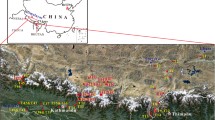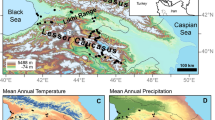Abstract
This research describes modern phytolith records and distributions from subalpine surface soils in the Dalaoling Forest Reserve, and reveals its implications for local climate conditions with respect to the altitude gradient. Well-preserved phytolith morpho-types, assemblages, and climatic indices were used to study the relationship between local vegetation and climate conditions. The phytolith classification system is mainly based on the characteristics of detailed morpho-types described for anatomical terms, which are divided into seven groups: long cells, short cells, bulliform cells, hair cells, pteridophyte type, broad-leaved type, and gymnosperm type. Phytoliths originating from the Poaceae are composed of Pooideae (rondel and trapeziform), Panicoideae (bilobate, cross, and polylobate), Chloridoideae (short/square saddle), and Bambusoideae (oblong concave saddle). Based on the altitudinal distribution of the phytolith assemblages and the indices of aridity (Iph), climate (Ic), and tree cover density (D/P), five phytolith assemblage zones have revealed the five types of climatic conditions ranging from 1,169 m to 2,005 m in turn: warm-wet, warm-xeric to warm-mesic, warm-xeric to cool-mesic, cool-xeric, and cool-mesic to cool-xeric. The Bambusoideae, Panicoideae, and Chloridoideae are the dominant vegetation at the lower-middle of the mountains, while Pooideae is mainly distributed in the higher mountains. The close relationship between phytolith assembleages and changes of altitude gradient suggest that vegetation distribution patterns and plant ecology in the Dalaoling mountains are controlled by temperature and humidity conditions. Our results highlight the importance of phytolith records as reliable ecoclimatic indicators for vegetation ecology in subtropical regions.
Similar content being viewed by others
References
Alexandre A, Meunier J D, Lezine A M, Vincens A, Schwartz D (1997). Phytoliths: indicators of grassland dynamics during the late Holocene in intertropical Africa. Palaeogeogr Palaeoclimatol Palaeoecol, 136(1–4): 213–229
Barboni D, Bonnefile R, Meunier J D, Alexandre A (1999). Phytoliths as Palaeoenvironmental indicator, west side middle awash valley, Ethiopia. Palaeogeography, Paleoclimatology, paleoecology, 152: 87–100
Brown D A (1984). Prospects and limits of a phytolith key for grasses in the central United States. J Archaeol Sci, 11(4): 345–368
Diester-Haass L, Schrader H J, Thiede J (1973). Sedimentological and palaeoclimatological investigations of two pelagic-ooze cores off Cape Barbas, North-West Africa. Meteor Forschungsergebnisse, 16: 19–66
Fredlund G, Tieszen L T (1994). Modern phytolith assemblages from the North American Great Plains. J Biogeogr, 21(3): 321–335
Fredlund G G, Tieszen L T (1997). Calibrating grass phytolith assemblages in climatic terms: application to late Pleistocene assemblages from Kansas and Nebraska. Palaeogeogr Palaeoclimatol Palaeoecol, 136(1–4): 199–211
Gu Y S, Huang X Y, Zhang W G, Hong H L, Li Y T (2013). Red palaeosols development in response to the enhanced East Asia summer monsoon since the mid-pleistocene in South China: evidence derived from magnetic properties and molecular fossil records. Journal of Earth Science, 24(3): 382–396
Gu Y S, Pearsall D M, Xie S C, Yu J X (2008). Vegetation and fire history of a Chinese site in southern tropical Xishuangbanna derived from Phytolith and charcoal records from Holocene sediments. J Biogeogr, 35: 325–341
Gu Y S, Wang H L, Huang X Y, Peng H X, Huang J H (2012). Phytolith records of the climate change since the past 15000 years in the middle reach of the Yangtze River in China. Front Earth Sci, 6(1): 10–17
Gu Y S, Yu J X, Xie S C, Huang J H (2007). Palaeoclimate changes derived from the records of core sediments spore-pollen and phytolith in the Jianghan Plain over the past 5000 years. Earth Science-Journal of China University, 32: 133–140 (in Chinese)
Hong H L, Gu Y S, Li R B, Zhang K X, Li Z H (2010). Clay mineralogy and geochemistry and their palaeoclimatic interpretation of the Pleistocene deposits in the Xuancheng section, southern China. J Quaternary Sci, 25(5): 662–674
Hong H L, Gu Y S, Yin K, Wang C, Li Z (2013). Clay record of climate change since the mid-Pleistocene in Jiujiang, south China. Boreas, 42(1): 173–183
ICPN Working Group: Madella M, Alexandre A, Ball T (2005). International code for phytolith nomenclature 1.0. Ann Bot (Lond), 96(2): 253–260
Lu H Y, Liu K B (2003). Phytoliths of common grasses in the coastal environments of southeastern USA. Estuar Coast Shelf Sci, 58(3): 587–600
Lu H Y, Wu N Q, Yang X D, Jiang H, Liu K B, Liu T S (2006). Phytoliths as quantitative indicators for the reconstruction of past environmental conditions in China I: phytolith-based transfer functions. Quat Sci Rev, 25(9–10): 945–959
Mulholland S C (1989). Phytolith shape frequencies in North Dakota grasses: a comparison to general patterns. J Archaeol Sci, 16(5): 489–511
Parker A G, Eckersley L, Smith M M, Goudie A S, Stokes S, Ward S, White K, Hodson M J (2004). Holocene vegetation dynamics in the northeastern Rub’al-Khali desert, Arabian peninsula: a phytolith, pollen and carbon isotope study. J Quaternary Sci, 19(7): 665–676
Piperno D R (1988). Phytolith Analysis: An Archaeological and Geological Perspective. San Diego: Academic Press, 15–80, 223–246
Piperno D R (1989). The occurrence of phytoliths in the reproductive structures of selected tropical angiosperms and their significance in tropical paleoecology, paleoethnobotany, and systematics. Rev Palaeobot Palynol, 61(1–2): 147–173
Piperno D R (2006). Phytoliths: A Comprehensive Guide to Archaeologists and Palaeoecologists. Maryland: Altamira Press, 23–44, 165–186
Piperno D R, Becker P (1996). Vegetational history of a site in the central Amazon basin derived from phytolith and charcoal records from natural soils. Quat Res, 45(2): 202–209
Piperno D R, Pearsall D M (1998). The silica bodies of tropical American grasses: morphology, taxonomy, and implications for grass systematic and fossil phytolith identification. Smithsonian Contributions to Botany, 85(85): 1–40
Shen Z H, Jin Y X, Wu J Q, Zhao Z E, Huang H D (2000). A study on the quantitative classification of forest communities of Dalaoling region at the Three Gorges. Journal of Wuhan Botany Research, 18: 99–108 (in Chinese with English abstract)
Shen Z H, Zhang X S (2000). The spatial pattern and topographic interpretation of the forest vegetation at Dalaoling Region in the Three Gorges. Acta Bot Sin, 2: 1089–1095 (in Chinese with English abstract)
Shen Z H, Zhang X S, Jin Y X (2001). A vertical gradient analysis of the flora of Dalaoling Mountain in the Three Gorges region, China. Acta Phytotaxonomica Sinica, 39: 260–268
Twiss P C (1987). Grass-opal phytoliths as climatic indicators of the Great Plains Pleistocene. In: Johnson W C, ed. Quaternary Environments of Kansas. Kansas geological survey guidebook, series 5: 179–188
Twiss P C (1992). Predicted world distribution of C3 and C4 grass phytoliths. Phytolith Systematics: Emerging Issues. In: Rapp G Jr, Mulholland S C, eds. New York and London: Plenum Press, 13–128
Twiss P C, Suess E, Smith R M (1969). Morphological classification of grass phytoliths. Soil Science Society of America, Proceedings, 33(1): 109–115
Wang Y J, Lu H Y (1993). Phytolith Study and Its Application. Beijing: China Ocean Press (in Chinese).
Wu J Q, Zheng Z, Jin Y X (1996). Studies on the flora of seed plants in Dalaoling. Journal of Wuhan Botanical Research, 14: 309–317 (in Chinese)
Author information
Authors and Affiliations
Corresponding author
Rights and permissions
About this article
Cite this article
Traoré, D.D., Gu, Y., Liu, H. et al. Vegetation types and climate conditions reflected by the modern phytolith assemblages in the subalpine Dalaoling Forest Reserve, central China. Front. Earth Sci. 9, 268–275 (2015). https://doi.org/10.1007/s11707-014-0475-2
Received:
Accepted:
Published:
Issue Date:
DOI: https://doi.org/10.1007/s11707-014-0475-2




